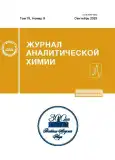Determination of Umifenovir and Its Metabolites by High-Performance Liquid Chromatography with Combined Mass Spectrometric Detection
- 作者: Sypalov S.A.1, Ul’yanovskii N.V.1, Kosyakov D.S.1, Lebedev A.T.1
-
隶属关系:
- Core Facility Center “Arktika”, M.V. Lomonosov Northern (Arctic) Federal University
- 期: 卷 78, 编号 9 (2023)
- 页面: 856-864
- 栏目: ORIGINAL ARTICLES
- ##submission.dateSubmitted##: 14.10.2023
- URL: https://journals.rcsi.science/0044-4502/article/view/136073
- DOI: https://doi.org/10.31857/S0044450223090153
- EDN: https://elibrary.ru/ZYKEYI
- ID: 136073
如何引用文章
全文:
详细
An approach to the highly sensitive and selective determination of the bromine-containing antiviral drug umifenovir (Arbidol) and its metabolites in natural and waste water, activated sludge, and bottom sediments by chromatography-mass spectrometry based on a combination of two techniques– inductively coupled plasma mass spectrometry (ICP MS) and electrospray ionization high-resolution mass spectrometry (ESI HRMS) is developed. Reversed-phase chromatographic separation and detection based on ESI HRMS provide the reliable detection and identification of analytes in complex matrices, while the use of ICP-MS with 79Br signal detection makes it possible to exclude matrix effects and use a single analytical standard for quantitative analysis. The use of solid-phase extraction and pressurized liquid extraction as sample preparation methods made it possible to achieve limits of detection at a level of 0.2 ng/L and 2 µg/kg for liquid and solid samples, respectively. The developed approach was successfully tested in the analysis of real samples. It is shown that the concentrations of analytes in urban wastewaters are in the range 4.4–260 ng/L. The highest concentration (up to 3.7 mg/kg) is characteristic of activated sludge, which acts as an effective sorbent for umifenovir and its transformation products.
作者简介
S. Sypalov
Core Facility Center “Arktika”, M.V. Lomonosov Northern (Arctic) Federal University
Email: n.ulyanovsky@narfu.ru
163002, Arkhangelsk, Russia
N. Ul’yanovskii
Core Facility Center “Arktika”, M.V. Lomonosov Northern (Arctic) Federal University
Email: n.ulyanovsky@narfu.ru
163002, Arkhangelsk, Russia
D. Kosyakov
Core Facility Center “Arktika”, M.V. Lomonosov Northern (Arctic) Federal University
Email: n.ulyanovsky@narfu.ru
163002, Arkhangelsk, Russia
A. Lebedev
Core Facility Center “Arktika”, M.V. Lomonosov Northern (Arctic) Federal University
编辑信件的主要联系方式.
Email: n.ulyanovsky@narfu.ru
163002, Arkhangelsk, Russia
参考
- Suda K.J., Hunkler R.J., Matusiak L.M., Schumock G.T. Influenza antiviral expenditures and outpatient prescriptions in the United States, 2003–2012 // Pharmacotherapy. 2015. V. 35. № 11. P. 991. https://doi.org/10.1002/phar.1656
- Трофимов Ф.А., Цышкова Н.Г., Зотова С.А., Гринев А.Н. Синтез нового противовирусного препарата Арбидола // Фармацевтический химический журнал. 1993. Т. 27. № 1. С. 75. (Trofimov F.A., Tsyshkova N.G., Zotova S.A., Grinev A.N. Synthesis of a new antiviral agent, arbidole // Pharm. Chem. J. 1993. V. 27. № 1. P. 75. )https://doi.org/10.1007/BF00772858
- Pécheur E.I., Borisevich V., Halfmann P., Morrey J.D., Smee D.F., Prichard M., Mire C.E., Kawaoka Y., Geisbert T.W., Polyak S.J. The synthetic antiviral drug arbidol inhibits globally prevalent pathogenic viruses // J. Virol. 2016. V. 90. № 6. P. 3086. https://doi.org/10.1128/JVI.02077-15
- Инструкция по медицинскому применению лекарственного препарата Арбидол. https://arbidol.ru/files/arbidol_maksimum_kapsuly_200_mg.pdf?v=20210224 (дата обращения 08.04.2023).
- Kuroda K., Li C., Dhangar, K., Kumar M. Predicted occurrence, ecotoxicological risk and environmentally acquired resistance of antiviral drugs associated with COVID-19 in environmental waters // Sci. Total Environ. 2021. V. 776. Article 145740. https://doi.org/10.1016/j.scitotenv.2021.145740
- Ul’yanovskii N.V., Kosyakov D.S., Sypalov S.A., Varsegov I.S., Shavrina I.S., Lebedev A.T. Antiviral drug Umifenovir (Arbidol) in municipal wastewater during the COVID-19 pandemic: Estimated levels and transformation // Sci. Total Environ. 2022. V. 805. Article 150380. https://doi.org/10.1016/j.scitotenv.2021.150380
- Proskurnina E.V., Izmailov D.Y., Sozarukova M.M., Zhuravleva T.A., Leneva I.A., Poromov A.A. Antioxidant potential of antiviral drug umifenovir // Molecules. 2020. V. 25. № 7. P. 1577. https://doi.org/10.3390/molecules25071577
- Muller A.L., Mello P.A., Mesko M.F., Duarte F.A., Dressler V.L., Muller E.I., Flores E.M. Bromine and iodine determination in active pharmaceutical ingredients by ICP-MS // J. Anal. At. Spectrom. 2012. V. 27. № 11. P. 1889. https://doi.org/10.1039/C2JA30212H
- Xie R., Johnson W., Spayd S., Hall G.S., Buckley B. Arsenic speciation analysis of human urine using ion exchange chromatography coupled to inductively coupled plasma mass spectrometry // Anal. Chim. Acta. 2006. V. 578. № 2. P. 186. https://doi.org/10.1016/j.aca.2006.06.076
- de Souza S.S., Campiglia A.D., Barbosa Jr F. A simple method for methylmercury, inorganic mercury and ethylmercury determination in plasma samples by high performance liquid chromatography–cold-vapor-inductively coupled plasma mass spectrometry // Anal. Chim. Acta. 2013. V. 761. P. 11. https://doi.org/10.1016/j.aca.2012.11.038
- McSheehy S., Pohl P., Łobiński R., Szpunar J. Investigation of arsenic speciation in oyster test reference material by multidimensional HPLC-ICP-MS and electrospray tandem mass spectrometry (ES-MS-MS) // Analyst. 2001. V. 126. № 7. P. 1055. https://doi.org/10.1039/B102225N
- Bierla K., Dernovics M., Vacchina V., Szpunar J., Bertin G., Lobinski R. Determination of selenocysteine and selenomethionine in edible animal tissues by 2D size-exclusion reversed-phase HPLC-ICP MS following carbamidomethylation and proteolytic extraction // Anal. Bioanal. Chem. 2008. V. 390. P. 1789. https://doi.org/10.1007/s00216-008-1883-5
- Klencsár B., Li S., Balcaen L., Vanhaecke F. High-performance liquid chromatography coupled to inductively coupled plasma–Mass spectrometry (HPLC-ICP-MS) for quantitative metabolite profiling of non-metal drugs // Trends Anal. Chem. 2018. V. 104. P. 118. https://doi.org/10.1016/j.trac.2017.09.020
- Liu D., Chen G., Huo Z., Liu H., Ji W., Liu H. A study of bromine speciation in human serum and ambroxol determination in rat plasma by liquid chromatography–inductively coupled plasma mass spectrometry // Chromatographia. 2019. V. 82. P. 927. https://doi.org/10.1007/s10337-019-03730-z
- Brauer G. Handbook of Preparative Inorganic Chemistry. New York: Academic Press Inc., 1993. 1906 p.
- Lyon T.D.B., Robin P.A., Watson W.S., Littlejohn D. Determination of elevated concentrations of bromine in serum by ICP-MS and ICP-OES // J. Anal. At. Spectrom. 2005. V. 20. № 8. P. 757. https://doi.org/10.1039/B417529H
- Kosyakov D.S., Ul’yanovskii N.V., Popov M.S., Latkin T.B., Lebedev A.T. Halogenated fatty amides – A brand new class of disinfection by-products // Water Res. 2017. V. 127. P. 183. https://doi.org/10.1016/j.watres.2017.10.008
补充文件













